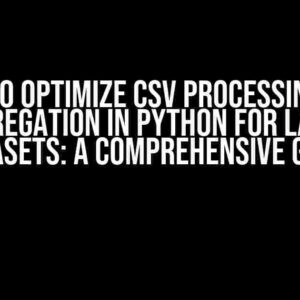Are you tired of encountering the frustrating “Received Import Error while importing an existing function” error? Don’t worry, you’re not alone! This error can be a nightmare for developers, but fear not, dear reader, for we have got you covered. In this exhaustive guide, we’ll take you by the hand and walk you through the process of identifying and resolving this pesky error once and for all.
- What Causes the Received Import Error?
- Step 1: Verify the Import Statement
- Step 2: Check the File Path and Directory Structure
- Step 3: Inspect the Module or Package
- Step 4: Check for Circular Imports or Dependencies
- Step 5: Verify the Python Path and sys.path
- Step 6: Restart Your IDE or Terminal
- Best Practices to Avoid the Received Import Error
- Conclusion
What Causes the Received Import Error?
Before we dive into the solution, let’s first understand what causes this error. The “Received Import Error while importing an existing function” error typically occurs when there’s a mismatch between the module or package you’re trying to import and the actual file or module that exists. This mismatch can be due to various reasons such as:
-
Typos in the import statement
-
Incorrect file paths or directory structures
-
Inconsistent naming conventions
-
Circular imports or dependencies
Step 1: Verify the Import Statement
The first step in resolving this error is to carefully examine the import statement that’s causing the issue. Double-check for any typos, incorrect capitalization, or incorrect file paths. Make sure the import statement is correctly formatted and adheres to the Python syntax rules.
from module_name import function_nameIn the above example, ensure that:
-
“module_name” is the correct name of the module or package
-
“function_name” is the correct name of the function you want to import
Step 2: Check the File Path and Directory Structure
The next step is to verify that the file path and directory structure are correct. Make sure the module or package you’re trying to import exists in the correct location and is correctly named. Use the following checklist to ensure everything is in order:
-
Check if the module or package exists in the correct directory
-
Verify that the file name and extension (e.g., .py) are correct
-
Ensure that the file is in the correct location within the project structure
Step 3: Inspect the Module or Package
Now, let’s take a closer look at the module or package itself. Make sure it’s correctly defined and that the function you’re trying to import exists within it. Follow these steps:
-
Open the module or package file in your code editor
-
Verify that the function you’re trying to import is defined within the module or package
-
Check if the function is correctly indented and formatted
Step 4: Check for Circular Imports or Dependencies
Circular imports or dependencies can also cause the “Received Import Error” issue. To identify and resolve this, follow these steps:
-
Identify the modules or packages that are being imported recursively
-
Reorganize the import statements to avoid circular dependencies
-
Use relative imports or import statements with the correct module names
Step 5: Verify the Python Path and sys.path
The Python path and sys.path can also affect the import process. Make sure that:
-
The Python path is correctly set
-
The module or package is in the sys.path
You can check the sys.path using the following code:
import sys
print(sys.path)Step 6: Restart Your IDE or Terminal
Sometimes, a simple restart can resolve the issue. Try restarting your IDE or terminal to ensure that any changes you made are reflected.
Best Practices to Avoid the Received Import Error
To avoid encountering the “Received Import Error” in the future, follow these best practices:
-
Use consistent naming conventions for modules, packages, and functions
-
Use relative imports or import statements with the correct module names
-
Avoid circular imports or dependencies
-
Organize your code in a logical and structured manner
Conclusion
In conclusion, the “Received Import Error while importing an existing function” error can be frustrating, but it’s not insurmountable. By following the steps outlined in this guide, you’ll be able to identify and resolve the issue quickly and efficiently. Remember to verify the import statement, check the file path and directory structure, inspect the module or package, check for circular imports or dependencies, verify the Python path and sys.path, and restart your IDE or terminal. With these steps and best practices, you’ll be well on your way to becoming an import error ninja!
| Step | Description |
|---|---|
| 1 | Verify the import statement |
| 2 | Check the file path and directory structure |
| 3 | Inspect the module or package |
| 4 | Check for circular imports or dependencies |
| 5 | Verify the Python path and sys.path |
| 6 | Restart your IDE or terminal |
Remember, with patience and persistence, you can conquer the “Received Import Error” and get back to coding like a pro!
Frequently Asked Question
Stuck with an import error while trying to use an existing function? Don’t worry, we’ve got you covered! Check out these common questions and answers to get back on track.
Q1: Why am I getting an import error for an existing function?
This error usually occurs when there’s a naming conflict or a circular import issue. Check if you’ve named your Python file the same as a module or if you’re importing modules in a circular fashion (e.g., module A imports module B, which imports module A). Rename the file or refactor your imports to resolve the issue.
Q2: Could the issue be related to my Python environment or version?
Yes, it’s possible! Make sure you’re using the correct Python environment and version. If you’ve recently updated Python or installed new packages, try reverting to a previous version or using a virtual environment to isolate the issue. Also, check if the function is compatible with your Python version.
Q3: How do I troubleshoot the import error step by step?
Start by checking the error message for specific details. Then, try importing the function in a separate Python script or using an interactive shell like Jupyter Notebook or Python REPL. If the issue persists, examine your import statements, file names, and module structures. Use tools like `pip freeze` or `conda list` to verify package installations and versions.
Q4: Can I use relative imports to solve the issue?
Yes, relative imports can help in some cases. Instead of using absolute imports, try using relative imports (e.g., `from .module import function`) to import the function. However, be cautious when using relative imports, as they can lead to complexity and maintenance issues in larger projects.
Q5: What if I’ve tried everything and still get the import error?
Don’t worry, it’s not uncommon! If you’ve exhausted all troubleshooting steps, try seeking help from online communities like Stack Overflow, Reddit’s r/learnpython, or Python forums. Share your code and error messages to get more specific guidance from experienced developers.





